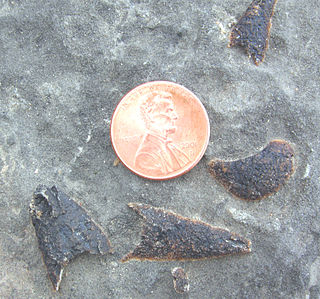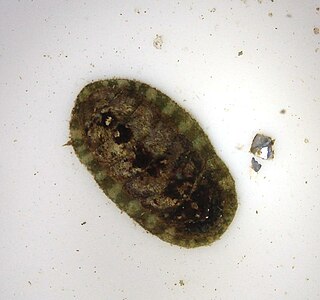
Chitons are marine molluscs of varying size in the class Polyplacophora, formerly known as Amphineura. About 940 extant and 430 fossil species are recognized.
Lepidopleurus is an extant genus of chitons in the family Leptochitonidae.

Mopalia spectabilis, commonly known as the red-flecked mopalia, is a species of chiton.

Tonicella is a genus of chitons known as the lined chitons.

Chiton magnificus, the liquorice sea cradle, is a Southeast Pacific species of edible chiton, a marine polyplacophoran mollusk in the family Chitonidae, the typical chitons.

Acanthopleura granulata, common name the West Indian fuzzy chiton, is a medium-sized tropical species of chiton. This type of chiton's activity does not depend on spring-neap oscillations leading to lower locomotion loss. Its morphology is different from usual chitons as it has a fifth valve, which is split into halves.

Matthevia is a genus of Cambrian molluscs, perhaps related to the chitons. It consists of repeated monoplacophoran-like shells; according to one hypothesis, chitons arose when these tall shells began to overlap over the generations. The tall element of the shell was retained and forms the tips of modern chiton plates. There are distinct head, 'centre', and tail valves, which occur approximately in the ratio 1:5:1 — suggesting a seven-plated configuration.
Hemithecella is a problematic genus of Ordovician mollusc proposed by Stinchcomb and Darrough in 1995. Hemithecella belongs to what are informally known as multiplated molluscs; it is found in the late Cambrian of the Ozarks and the Lower Ordovician of the same region as well as in Minnesota and the southern Appalachian Mountains. Hemithecella has muscle scars identical to a monoplacophoran and not the musculature of a chiton to which some authors have suggested the multiplated molluscs belong. It is therefore classified in the Mattheviidae.
Paradycheia is a genus of polyplacophoran known from the Upper Cambrian Eminence Dolomite, Missouri, USA.
Dycheiidae is a wastebasket taxon containing problematic polyplacophora from Upper Cambrian strata in the USA.
Aulochiton is a genus of upper Cambrian chitons with a circular head valve.

Mattheviidae is an extinct taxonomic family of fossil chitons, marine polyplacophoran mollusks that are found in Cambrian-Silurian deposits.

Hanleya is a genus of polyplacophoran molluscs known from Oligocene and Miocene fossils; it is represented today by a number of species including H. sinica Xu 1990 (China), H. brachyplax (Brazil) and H. hanleyi Bean in Thorpe, 1844 (Chile), which feeds on sponges.

Mopaliidae is a family of marine molluscs in the class Polyplacophora.
Acutichiton is among the most primitive genera of Neoloricate chitons. Acutichiton became extinct during the Carboniferous period. Articulated specimens are known.

Placiphorella, the veiled chiton, is a genus of polyplacophoran molluscs with precephalic tentacles, which are used in feeding.

Lepidochitona is a genus of chitons. It has been included in the families Tonicellidae, Ischnochitonidae, and Lepidochitonidae.
Nuttallochiton is a genus of chitons; the only one to have paired rather than fused gonads.
Polysacos is an extinct genus of multiplacophorans (chitons) known from articulated Carboniferous fossils; its seventeen shell plates are arranged in three rows, with seven iterated units. It demonstrates that multiplacophora are related to modern polyplacophora. It was fringed with a ring of hollow spines resembling those of the Ordovician Echinochiton.
Pedanochiton is a Permian Neoloricate chiton.








